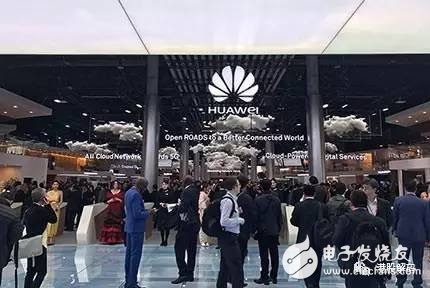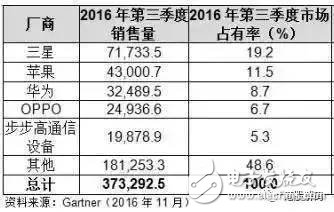At the World Mobile Communications Conference (MWC2017), which was just concluded, more than half of the mainstream mobile phones from the participating companies came from China. Huawei, ZTE, Jinli, Meizu and OPPO all debuted new products or innovative technologies. Undoubtedly, when domestic market demand is close to saturation, it is an inevitable trend to seek opportunities overseas. Among them, Huawei is the most prominent. After further consolidating its position in the domestic market, Huawei has also entered the European and American markets in the past two years, and aims to target the high-end market. Through the Mate series and the P series, Huawei broke through the blank price of 4,000 yuan for domestic mobile phones and successfully broke through in the high-end market.
In the door of the overseas market, Huawei has achieved good results. In the first half of 2016, the sales revenue of Huawei's smartphone overseas market was 1.6 times that of the domestic market. Especially in the European market, Huawei has a market share of more than 20% in five countries, including Spain. In the Western European market, Huawei’s smartphone market share is 11.6%; the high-end smartphone market with a price of 500-600 euros, Huawei The share reached 14.3%. At present, Huawei has basically completed its goal of entering the European market. Its share is stable at more than 5%, and the next target is to break through 5%, reaching 10% to 12%.

The increase in income behind the scenery does not increase profits and attract attention
However, when Huawei triumphed in overseas markets, its short-term increase in revenue did not increase the market's attention. In the past two years, the profit margin of Huawei's mobile phone business was too low to meet the Group's profit target. From Ren Zhengfei’s recent speech to Huawei, Huawei is indeed in urgent need of increasing sales gross profit.
Indeed, in terms of momentum, Huawei is in the limelight. According to data released by research firm GFK, in the third quarter of 2016, Huawei ranked the top three in the world with 8.7% of global market share. Samsung and Apple respectively It is 19.2% and 11.5%. Strong offline channels have also allowed manufacturers such as OPPO and vivo to rise. In terms of growth comparison, Samsung and Apple's market share is shrinking, followed by the growth of the three mobile phone manufacturers.
However, in terms of profit, Huawei is far less impressive than its market share. According to Huawei's 2016 annual report, its profit margin is only about 7%. It is reported that Huawei's revenue in 2016 increased by more than 130 billion yuan compared with 2015, but the profit is It only increased by 1 billion yuan, which means that over 130 billion yuan of income has little contribution to effective profits.
In the mobile phone market, in the third quarter of 2016, the global smartphone market had a total operating profit of $9.4 billion, while the Apple family accounted for $8.5 billion. Apple used only 11% of the market share. 91% of the global mobile phone market. China's Huawei, Vivo and OPPO handset manufacturers are ranked 234, but profits accounted for only 2.4%, 2.2% and 2.2%.
Huge investment highlights the ambition of Huawei's future
There are several reasons why Huawei's mobile phone business has a low profit margin in recent years. In the process of opening up overseas markets, Huawei paid a lot of tuition fees. For example, in international marketing, Huawei hired Argentine football player Rio Messi and superstars last year. Scarlett-Johnson and Henry Caville are brand ambassadors. But these expenses did not allow them to win the expected market share.

However, the main reason is that Huawei has invested heavily in technology research and development in recent years. In recent years, many mobile phone manufacturers in China have been thinking about the Internet. Most of the investment in R&D is not taken seriously, while Huawei is different. Its R&D investment accounts for an increase in revenue from year to year, from 10% in the past to 15% last year. In 2015, Huawei invested nearly 60 billion yuan in research and development, ranking among the top five in the world. At the same time, Huawei also won the first patent technology treaty in 2015 with 3,8 patent applications.
It is precisely for the future technology that does not cost the investment, Huawei's Kirin chip has been greatly used in the past two years. Applied in Huawei's high-end mobile phones, its performance has been at the leading level in the industry. Data shows that as of December last year, Kirin's cumulative shipments exceeded 50 million. However, little is known about the hardships. Huawei’s manpower and financial resources are very alarming. Huawei has set up an ASIC design center since 1991, and it has been waiting for 22 years. The Kirin 910 has only begun to be commercialized. Facing the future, Huawei seems to be striving to build an industry chain comparable to Samsung. On the basis of mobile phone chip research and development, semiconductor manufacturing, and memory chip research and development, it may enter the panel and CMOS industries in the future.
However, Huawei's most urgent goal now is how to turn the large-scale investment into profit in the early stage. Although Huawei has a thick foundation, it can support the expansion and development of the mobile phone business with other business departments. However, after all, the company relies on profits. Huawei’s Ren Zhengfei also said that Huawei’s future goal should be to surpass Samsung’s Apple in terms of profit and service level, rather than sales. However, Huawei has a long way to go before it can do this.
Piezoelectric Elements For Inkjet Piezo Transducer
Piezoelectric ceramic ring
Applications: ultrasonic vibration tranducer for inkjet printer
Vibration mechanism of inkjet printer:
Generally, it is composed of piezoelectric ceramics and driving rods. By high-frequency electric excitation, piezo ceramics produce high-frequency ultrasonic vibration (above 60 kHz or higher), which is transmitted to the driving rod and generates high-frequency micro-displacement (back and forth expansion) at its front end.
Piezo ceramics components features :
1. High vibration amplitude and can withstand higher power.
2. The product has high reliability, strong maintainability, and is not easy to break down or off-line.
3. The frequency can be adjusted in a wide range, generally within the range of 10KHz.
Yuhai support all the new developping transducer, Welcome the customized elements inquiry.
The present piezoelectric elements for Inkjet piezo transducer is following :
Piezo rings OD4*ID2*2.5mm price USD1.20/pc, 2000pcs
Material: PBaS-4
Fr.: 694 KHz ±5KHz
K33: ≥0.55
Tg loss <0.5%
Ct 60pF ±12.5%
Piezo rings OD4*ID2*2.5mm price USD1.20/pc, 2000pcs
Material: PSnN-5
Fr.: 626KHz ±5KHz
K33: ≥0.57
Tg loss < 2%
Ct 53pF ±12.5%
Piezo rings OD6*ID2.5*2mm price USD1.50/pc, 2000pcs
Material: PZT-41
Fr.: 785 KHz ±5KHz
K33: >0.53
Tg loss < 0.5%
Ct 107 pF ±12.5%
Piezo rod OD3*7mm price USD1.20/pc, 2000pcs
Material: PLiS-51
Fr.: 192 KHz ± 3KHz
K33: >0.62
Tg loss < 2%
Ct 18.7 pF ±12.5%
Inkjet Piezo Transducer,Piezoelectric Vibration Transducer,Piezoelectric Rings,Piezoelectric Elements For Inkjet Piezo Transducer
Zibo Yuhai Electronic Ceramic Co., Ltd. , https://www.yhpiezo.com
